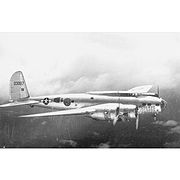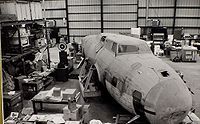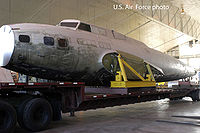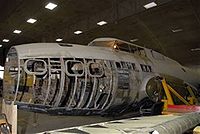
The Swoose
Encyclopedia

World War II
World War II, or the Second World War , was a global conflict lasting from 1939 to 1945, involving most of the world's nations—including all of the great powers—eventually forming two opposing military alliances: the Allies and the Axis...
and survived to become the oldest B-17 still intact. It is the only early "shark fin" B-17 known to exist. It is also the only existing B-17 to have seen action in the 1941-42 Philippines Campaign, the first day of the United States entry into the war. A recent controversy on how best to restore and display the aircraft has caused the National Museum of the United States Air Force
National Museum of the United States Air Force
The National Museum of the United States Air Force is the official museum of the United States Air Force located at Wright-Patterson Air Force Base northeast of Dayton, Ohio. The NMUSAF is the world's largest and oldest military aviation museum with more than 360 aircraft and missiles on display...
to suspend restoration of the aircraft.
Early history
The 38th of 42 B-17Ds built by Boeing, 40-3097 was accepted by the Army Air CorpsUnited States Army Air Corps
The United States Army Air Corps was a forerunner of the United States Air Force. Renamed from the Air Service on 2 July 1926, it was part of the United States Army and the predecessor of the United States Army Air Forces , established in 1941...
on 25 April 1941 in Seattle, Washington. It was ferried to Hickam Field, Hawaii, 13–14 May 1941, by the 19th Bomb Group as part of a group of 21 B-17C and Ds slated to equip the 11th Bomb Group. In response to the perceived hostile activities of the Japanese military, in September 1941, the War Department sent nine B-17s based in Hawaii to Clark Field, the Philippines, assigned to the 14th Bomb Squadron, 11th Bomb Group aircraft number 21, arriving at Del Monte, the only field besides Clark that could handle the Fortresses, on 12 September.
The Japanese surprise attacks of 8 December 1941 on military installations on Clark Field and the Philippine Islands, eight hours after the Pearl Harbor raid, caught much of the United States military on the ground and only 17 of the 35 Flying Fortresses escaped destruction. One of the survivors, 40-3097, named "Ole Betsy", was pressed into bombing duty for the next two months until newer B-17Es began to reach the Pacific in January 1942. Spare parts were scarce and ground crews patched up battle damage with parts salvaged from other destroyed aircraft. The last combat mission flown by 40-3097 was a raid on the east coast of Borneo on 11 January 1942, piloted by the commander of the 19th Bomb Group, Major Cecil Combs.
Half swan, half goose
In late January 1942, 40-3097 was flown to a Royal Australian Air ForceRoyal Australian Air Force
The Royal Australian Air Force is the air force branch of the Australian Defence Force. The RAAF was formed in March 1921. It continues the traditions of the Australian Flying Corps , which was formed on 22 October 1912. The RAAF has taken part in many of the 20th century's major conflicts...
Base at Laverton
Laverton, Victoria
Laverton is a suburb in Melbourne, Victoria, Australia, 17 km south-west from Melbourne's central business district. Its Local Government Area are the Cities of Hobsons Bay and Wyndham. At the 2006 Census, Laverton had a population of 4508.-History:...
, near Melbourne, Australia, where it underwent depot repairs. At this time, the tail of 40-3091 was grafted onto 40-3097, leading 19th Bomb Group pilot Captain Weldon Smith to dub the aircraft "The Swoose" after the popular song Alexander the Swoose from a ditty written by Franklin Furlett and performed by bandleader Kay Kyser
Kay Kyser
James Kern Kyser was a popular bandleader and radio personality of the 1930s and 1940s.-Early years:He was born in Rocky Mount, North Carolina, the son of pharmacists Paul Bynum Kyser and Emily Royster Kyser. Editor Vermont C. Royster was his cousin...
about a bird that was "half swan, half goose: Alexander is a swoose". A depiction of the chimerical bird was soon painted on the starboard fuselage just aft of the main entrance door with the hopeful statement "It Flys" (sic). The aircraft never returned to first-line duty, apparently flying navigation escort missions for fighters and anti-submarine patrols, but was withdrawn from duty in March 1942 as it was in very poor condition by this time.
General's transport
While parked at Laverton, it was still deemed the best thing available at the airfield, and was selected by Captain Frank KurtzFrank Kurtz
Col. Frank Allen Kurtz is known as an Olympic diver, as an aviator, the United States Army Air Force being awarded the Croix de Guerre, 3 Distinguished Flying Crosses, 3 Silver Stars, 3 Air Medals, 5 Presidential Citations...
to serve as the personal transport for General George Brett
George Brett (military)
George Howard Brett was a United States Army Air Forces General during World War II. An Early Bird of Aviation, Brett served as a staff officer in World War I...
, then the Deputy Commander of Allied Forces in Australia, and ranking American commander. It carried various military brass for the next four months, including future president Lyndon B. Johnson
Lyndon B. Johnson
Lyndon Baines Johnson , often referred to as LBJ, was the 36th President of the United States after his service as the 37th Vice President of the United States...
, then a congressman and active-duty US Navy Lieutenant Commander. On a flight from Darwin
Darwin, Northern Territory
Darwin is the capital city of the Northern Territory, Australia. Situated on the Timor Sea, Darwin has a population of 127,500, making it by far the largest and most populated city in the sparsely populated Northern Territory, but the least populous of all Australia's capital cities...
on June 11, 1942, the crew had navigation problems and Kurtz had to make a forced landing at Carisbrooke Station near Winton, Queensland
Winton, Queensland
-Qantas:Winton was one of the founding towns of the Australian airline Qantas. The first board meeting was held at the Winton Club on 10 February 1921.-Waltzing Matilda:...
. When General Brett was reassigned to the Caribbean Defense Command following friction between him and General Douglas MacArthur
Douglas MacArthur
General of the Army Douglas MacArthur was an American general and field marshal of the Philippine Army. He was a Chief of Staff of the United States Army during the 1930s and played a prominent role in the Pacific theater during World War II. He received the Medal of Honor for his service in the...
, the Swoose ferried him to Washington, D.C., in August 1942, setting a number of speed records in the process. Used for a War Bond tour, 40-3097 continued to serve as General Brett's personal transport through 1944.
Upgrade
A routine inspection in February 1944 at Albrook Field in the Panama CanalPanama Canal
The Panama Canal is a ship canal in Panama that joins the Atlantic Ocean and the Pacific Ocean and is a key conduit for international maritime trade. Built from 1904 to 1914, the canal has seen annual traffic rise from about 1,000 ships early on to 14,702 vessels measuring a total of 309.6...
Zone uncovered cracked wing spars and other corrosion. While this would normally result in scrapping, Brett's pilot at the time, Captain Jack Crane, located a pair of B-17B wing panels in the local depot and the aircraft was rebuilt with much of the equipment brought up to B-17E standard. The aircraft was redesignated an RB-17D in late 1944 (obsolete) but continued to be assigned to General Brett until December 1945, when the general himself flew the last operational flight from Los Angeles to Kirtland Field, Albuquerque, New Mexico, for disposal.
War memorial

War Assets Administration
The War Assets Administration was established in the Office for Emergency Management, effective March 25, 1946, by EO 9689, January 31, 1946. American factorieshad produced massive amounts of weaponry during the World War II...
facility at Kingman, Arizona
Kingman, Arizona
Kingman is located in a desert climate on the edge of the Mojave Desert, but its higher elevation and location between the Colorado Plateau and the Lower Colorado River Valley tempers summer high temperatures and contributes to winter cold and rare snowfall. Summer daytime highs reach above 90 °F ...
, slated to be smelted down for its aluminium
Aluminium
Aluminium or aluminum is a silvery white member of the boron group of chemical elements. It has the symbol Al, and its atomic number is 13. It is not soluble in water under normal circumstances....
. At this point, Colonel Frank Kurtz persuaded the City of Los Angeles to retrieve the bomber for use as a war memorial in March 1946, with the bomber arriving at Los Angeles Municipal Airport on 6 April 1946. However, three years later, the city still had not found an appropriate place to display the historic airframe and in January 1949 it was donated by the city fathers to the National Air Museum in Washington, D.C. Refurbished at March Air Force Base, Riverside, California, for its delivery flight, it was flown by Kurtz with National Air Museum curator Paul Garber
Paul Garber
Paul Garber is a primatologist and the author and editor of several books and articles about primates. He is a professor at the University of Illinois. He is editor of the American Journal of Primatology and director of research and education at La Suerte Biological Field School in Costa Rica...
aboard to a storage facility at Park Ridge, Illinois
Park Ridge, Illinois
-Climate:-Demographics:As of the census of 2000, there were 37,775 people, 14,219 households, and 10,465 families residing in the city. The population density was 5,374.6 people per square mile . There were 14,646 housing units at an average density of 2,083.8 per square mile...
, on 26 March 1949. In January 1950 it was flown to Pyote, Texas
Pyote, Texas
Pyote is a town in Ward County, Texas, United States. The population was 131 at the 2000 census.-History:Pyote began as a small town. Its fortunes rose with oil, but its population decreased when the railroad was built away from the town. At one time Pyote had 3,500 residents...
, for additional storage, and then in December 1953 it was airborne one last time to Andrews Air Force Base
Andrews Air Force Base
Joint Base Andrews is a United States military facility located in Prince George's County, Maryland. The facility is under the jurisdiction of the United States Air Force 11th Wing, Air Force District of Washington ....
in Maryland, arriving there on 5 December on three engines. It is unlikely that an air delivery of such an artifact would be attempted now.
Deterioration
The Swoose was stored outside at Andrews until April 1961, during which time it suffered at the hands of both the weather and vandals, who picked the airframe clean of souvenirs. It was finally dismantled and moved several miles overland to the National Air and Space MuseumNational Air and Space Museum
The National Air and Space Museum of the Smithsonian Institution holds the largest collection of historic aircraft and spacecraft in the world. It was established in 1976. Located in Washington, D.C., United States, it is a center for research into the history and science of aviation and...
's Silver Hill
Paul E. Garber Preservation, Restoration, and Storage Facility
The Paul E. Garber Preservation, Restoration, and Storage Facility is located in Suitland, Maryland, USA. The facility, also nicknamed "Silver Hill", is where the Smithsonian Institution's National Air and Space Museum restores aircraft, spacecraft, and other artifacts.It is named in honor of...
facility, where it suffered additional weather damage while stored outside. Amidst mounting criticism about the treatment of historic artifacts like the Swoose and the B-29 "Enola Gay
Enola Gay
Enola Gay is a Boeing B-29 Superfortress bomber, named after Enola Gay Tibbets, mother of the pilot, then-Colonel Paul Tibbets. On August 6, 1945, during the final stages of World War II, it became the first aircraft to drop an atomic bomb as a weapon of war...
," the Smithsonian finally moved 40-3097 indoors in a dismantled state in the mid-1970s.
Move to Dayton

The Washington Post
The Washington Post is Washington, D.C.'s largest newspaper and its oldest still-existing paper, founded in 1877. Located in the capital of the United States, The Post has a particular emphasis on national politics. D.C., Maryland, and Virginia editions are printed for daily circulation...
reported on 3 November 2007 that the Air and Space Museum's collections committee, an advisory group on the acquisition and transfer of aircraft, had voted 5–4 on 28 September 2007 for deaccessioning The Swoose, and transfer it to the National Museum of the United States Air Force
National Museum of the United States Air Force
The National Museum of the United States Air Force is the official museum of the United States Air Force located at Wright-Patterson Air Force Base northeast of Dayton, Ohio. The NMUSAF is the world's largest and oldest military aviation museum with more than 360 aircraft and missiles on display...
in Dayton, Ohio. The panel forwarded its decision to Gen. John R. "Jack" Dailey, the museum director, and Donald S. Lopez Sr., the deputy director, who subsequently decided to stand by the committee's recommendation. "There were good arguments on both sides," said Dailey, who had requested a collections review to alleviate a storage crunch at the Silver Hill, Maryland, facility where The "Swoose" has been stored since 1961. The "Swoose" has never been in a plan to be displayed, Dailey said. A recommended condition of this transfer was that the National Museum of the United States Air Force transfer ownership of a restored B-17 to the National Air Space Museum's Udvar V. Hazy site for display, as that museum lacks a B-17. The matter was discussed by the governing board of the Dayton museum, and with the recent arrival of the B-17F Memphis Belle it was decided that continued display of the Museum's B-17G "Shoo Shoo Baby" would be unnecessary. Upon completion of the restoration and display of the "Swoose", estimated to occur in 2011, the B-17G "Shoo Shoo Baby" will be transferred to the Washington D.C. museum for display (Memphis Belle is not expected to be completed until 2015). This decision raised some concerns among the staff and patrons of the Dayton museum, as "Shoo Shoo Baby" is one of the world's finest restored examples of a B-17G, and has been a popular exhibit at the museum for many years. It was eventually pointed out that with the display of the "Swoose" and eventual display of the Memphis Belle the National Museum of the United States Air Force will possess the world's two most historically significant B-17s, and another B-17G model can easily be obtained when funds and space become available.

"We are pleased that The Swoose is coming to the National Museum of the U.S. Air Force," said senior curator Terry Aitken. "The transfer between the two federal institutions is a demonstration of good stewardship of our national historic collection. Our museum's restoration staff will use their experience and expertise being gained from the restoration of the famous Memphis Belle to accurately restore The Swoose, which is so important to our history."
As of fall 2008, the NMUSAF has begun restoration of the Swoose. The Swoose has undergone a limited inspection and a more extensive and detailed technical inspection is planned. Based on the findings, the museum will determine how to best restore and display the historic aircraft. The extensive restoration is expected to take a number of years. The Swoose is being restored at the same time as Memphis Belle, though it is expected the Swoose restoration will be completed many years before Memphis Belle.
Controversy and recent developments
In 2011, the restoration gained some controversy when it was announced that the Swoose would be restored to the appearance of a conventional armed B-17D used in the Philippines in early 1942, not in the configuration of General George BrettGeorge Brett (military)
George Howard Brett was a United States Army Air Forces General during World War II. An Early Bird of Aviation, Brett served as a staff officer in World War I...
's personal transport. This decision has prompted a write-in campaign urging the museum to reverse its decision and restore the aircraft to the configuration and markings of the aircraft while operated as the Swoose.
The controversy is based upon two opposing views on how the aircraft should be restored and displayed;
- The Swoose is the last surviving example of a B-17D, the early "Shark Fin" configuration that saw extensive action on December 7/8, 1941. In addition, the Swoose is one of the only intact surviving aircraft to have seen action on December 7/8. This view is that the aircraft should be restored to its original configuration as a B-17D stationed at Del Monte Air Field on December 7, 1941, as a tribute to all the early B-17 models that saw combat in the first days of the war.
- The Swoose is no longer a B-17D, but rather a unique aircraft with a legendary history that should be preserved in its modified configuration as a historically significant aircraft. This view is that the aircraft has a significant history that exceeds its importance as a B-17D.
Because both positions have historical merit, in summer 2011 restoration work on the Swoose was suspended indefinitely, pending a further review by museum staff on the best configuration in which to restore and display the Swoose.
Literature and arts
- In the W. E. B. GriffinW. E. B. GriffinW. E. B. Griffin is a writer of military and detective fiction with 38 novels in six series published under that name. He has also published under several pseudonyms....
The Corps series of novels, one of the main characters reports having flown aboard The Swoose. - Reference is made to The Swoose in the Battle of GuadalcanalGuadalcanal campaignThe Guadalcanal Campaign, also known as the Battle of Guadalcanal and codenamed Operation Watchtower by Allied forces, was a military campaign fought between August 7, 1942 and February 9, 1943 on and around the island of Guadalcanal in the Pacific theatre of World War II...
section of Leon UrisLeon UrisLeon Marcus Uris was an American novelist, known for his historical fiction and the deep research that went into his novels. His two bestselling books were Exodus, published in 1958, and Trinity, in 1976.-Life:...
' 1953 novel Battle Cry. Several of his characters are given a tour of the airplane at Henderson FieldHenderson Field (Guadalcanal)Henderson Field is a former military airfield on Guadacanal, Solomon Islands during World War II. Today it is Honiara International Airport.-Japanese construction:...
. - Actress Swoosie KurtzSwoosie KurtzSwoosie Kurtz is an American actress. She began her career in theater during the 1970s and shortly thereafter began a career in television, garnering ten nominations and winning one Emmy Award. Her most famous television project was her role on the 1990s NBC drama Sisters...
(Colonel Kurtz's daughter) was named after The Swoose.

